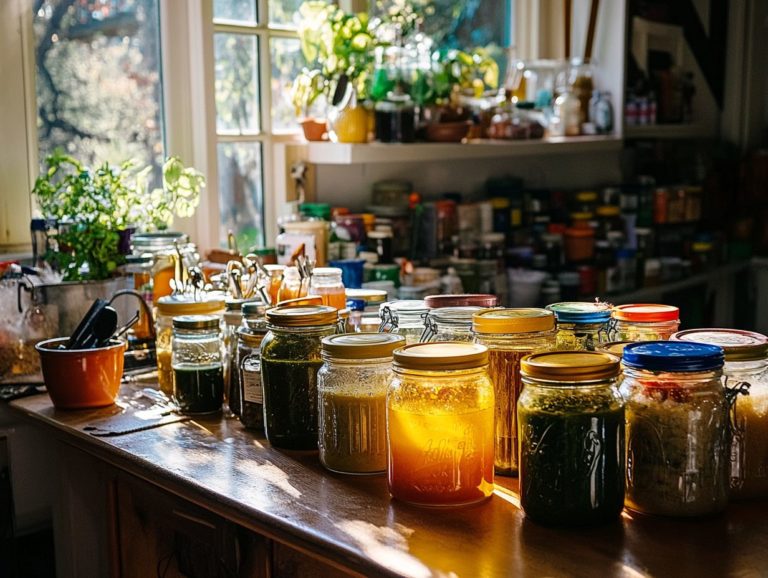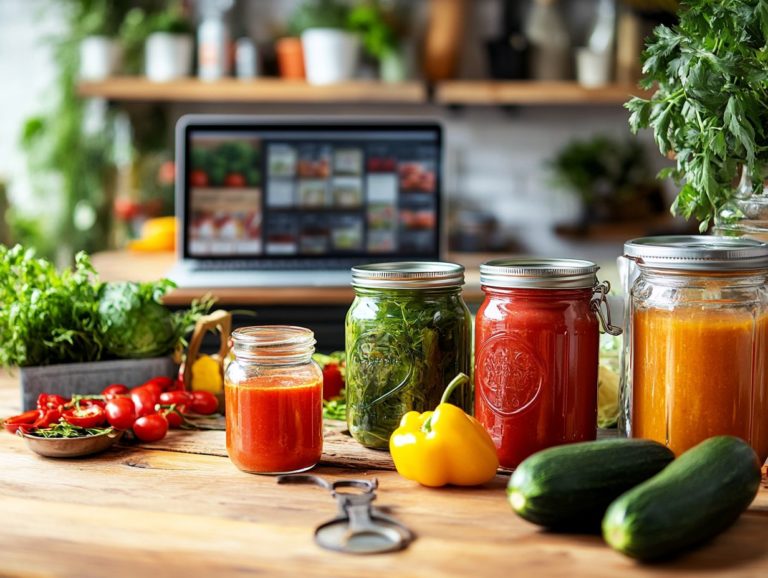Best Practices for Canning Equipment Storage
Proper storage of your canning equipment is essential for ensuring both food safety and the longevity of your tools.
Whether you re a seasoned canning enthusiast or just embarking on this rewarding journey, grasping the nuances of selecting the right storage location and maintaining your equipment can significantly enhance your experience.
This guide will help you learn key tips that will make your canning easier and more fun! Prepare to elevate your canning experience to new heights!
Contents
- Key Takeaways:
- Why Proper Storage is Important
- Choosing the Right Storage Location
- Preparing Canning Equipment for Storage
- Storing Canning Equipment
- Common Mistakes to Avoid
- Reusing Canning Equipment
- Frequently Asked Questions
- What are the best practices for storing canning equipment?
- How should I clean my canning jars and equipment before storing it?
- Is it necessary to store canning equipment in a specific temperature?
- What types of canning equipment should be stored separately?
- Should I label jars and my stored canning equipment?
- How often should I inspect my stored canning equipment?
Key Takeaways:
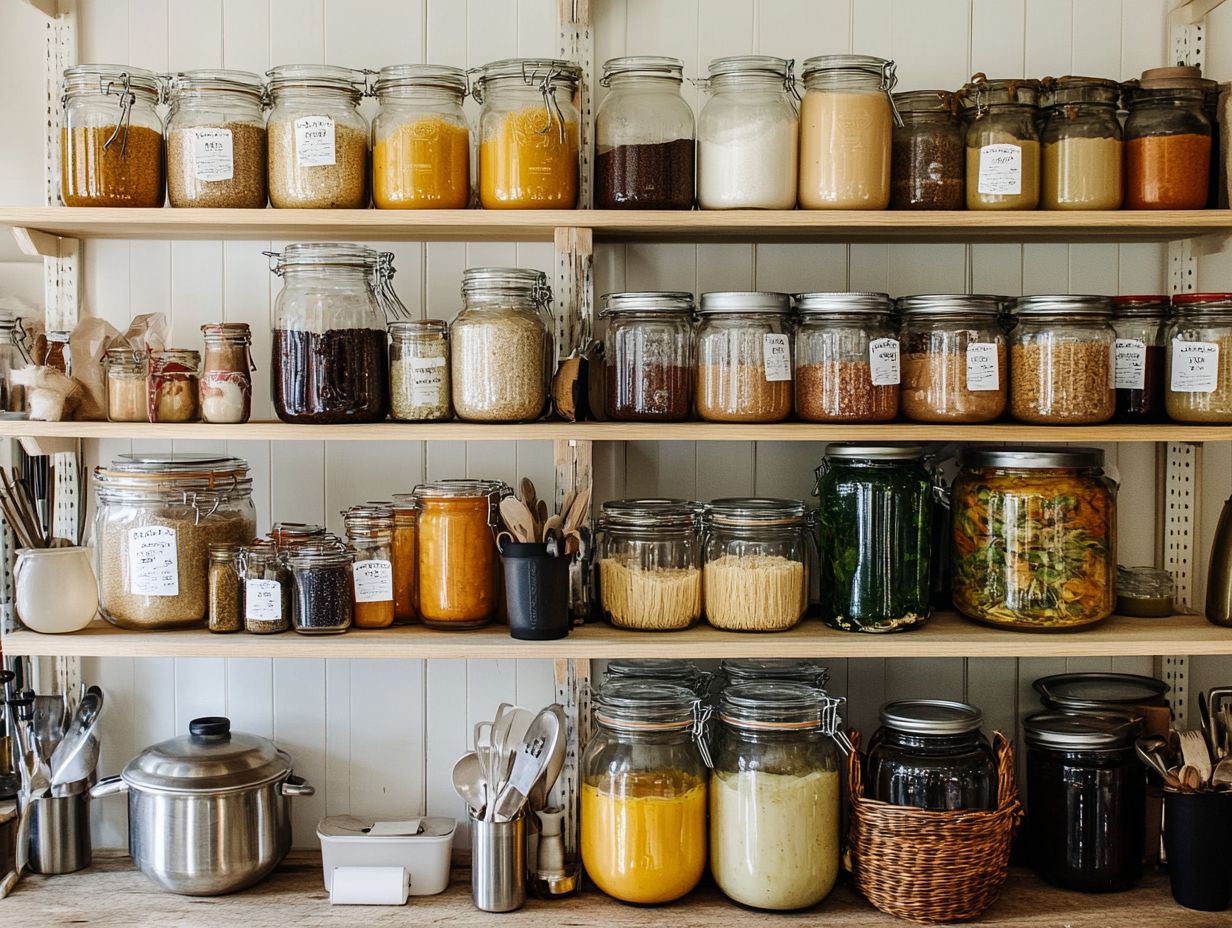
- Proper storage is crucial for keeping your canning equipment safe and effective.
- Choose a storage location with low humidity and good air circulation.
- Regular cleaning and careful storage will extend the life of your equipment.
Why Proper Storage is Important
Proper storage of your canning supplies and equipment is vital for maintaining food safety and ensuring that your preserved foods stay in peak condition. As you handle canning jars, lids, and other equipment, be sure to follow best practices for safe canning equipment use and watch for issues like moisture, temperature, and organization within your kitchen or pantry.
A thoughtfully organized storage system will help you prevent rust and contamination, setting the stage for a successful canning season come spring and summer.
Choosing the Right Storage Location
Choosing the ideal storage location for your canning supplies is crucial for maintaining the longevity and safety of your preserved foods. Whether you opt for a dedicated pantry, kitchen shelves, or even a mudroom, it’s essential that your storage area remains cool, dry, and well-organized. For more details, check out this guide on how to store canned goods properly.
This will help prevent contamination and ensure your canning jars stay in optimal condition. Consider how easy it is to access your canning equipment and supplies, especially during the bustling canning season.
Factors to Consider
When determining the best storage conditions for your canning supplies, you must consider several critical factors, including temperature, how wet it is, and organizational strategies. Maintaining the right temperature is essential to prevent spoilage, while reducing moisture exposure protects your jars and lids from rust. An effective organization system ensures you can quickly locate your supplies and uphold food safety.
To optimize these conditions, aim for a cool, dark place with temperatures ideally below 75 F. Utilizing airtight containers will help you manage moisture levels, keeping unwanted humidity at bay and preventing mold growth.
Regularly checking your inventory and implementing labeling systems will keep your materials easily accessible and safe. Consider using shelving units to elevate everything off the ground, enhancing airflow around your supplies.
Periodically reassessing these conditions allows you to make timely adjustments, ensuring the longevity and quality of your canned goods.
Preparing Canning Equipment for Storage
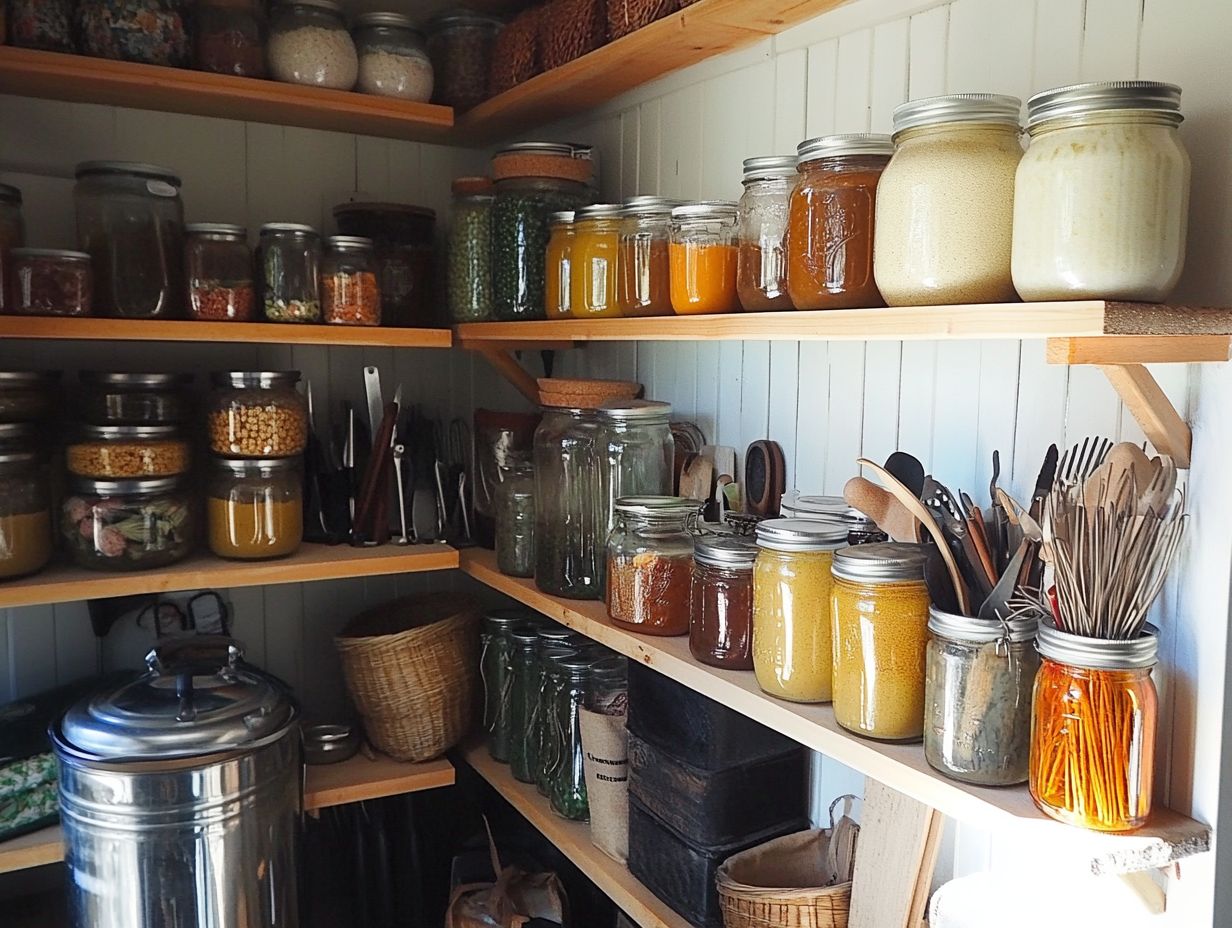
Preparing your canning equipment for storage is vital for ensuring both its longevity and the quality of your preserved food. Before you tuck away jars, lids, and bands, consider following best practices for canning on a budget and take the time to clean them thoroughly to ward off any potential contamination.
Establish a well-organized system for storing empty jars that protects them from damage and makes them easily accessible for your next canning adventure. Don’t wait until the last minute get your supplies ready now!
Cleaning and Maintenance Tips
Start by washing your jars and canning lids in hot, soapy water. Check for any damage or rust while cleaning.
Let the jars and lids air dry completely before storing them. Any lingering moisture can invite mold and bacteria. Don’t forget to clean and dry the bands too, as leftover food particles can jeopardize the seal during the canning process.
Routine inspections go beyond cleanliness; be vigilant in checking for rust or signs of wear that could spell trouble for your equipment. By keeping a detailed tracking chart, you can easily schedule cleanings and know when to replace worn-out items. This ensures safety in your kitchen and improves organization.
Storing Canning Equipment
Storing your canning equipment effectively ensures easy access and proper maintenance, highlighting the importance of proper canning equipment storage, both essential for successful food preservation.
With many storage ideas available, you can creatively organize your jars, lids, and other supplies to maximize space in your kitchen or pantry.
Consider implementing shelves, containers, or dedicated storage areas to keep everything in order and easily accessible for your next canning season.
Best Practices for Different Types of Equipment
Different types of canning equipment require specific storage practices to ensure their effectiveness and longevity. For instance, store pressure canners and waterbath canners in a cool, dry place. Additionally, maintaining your canning equipment is crucial, so organize jars by size: standard mouth, wide mouth, quart jars, and pint jars. Paying attention to these details in your storage solutions can greatly influence your canning success during the preserving season.
For pressure canners, ensure the gasket and gauge remain undamaged. Place them on a sturdy shelf away from moisture. Additionally, knowing how to organize your canning kitchen will help position waterbath canners in easily accessible areas to prevent delays when you’re ready to can.
Grouping jars by type and size simplifies identifying what you have and reduces the risk of breakage. Use labeled bins or shelving units to elevate your organization game, ensuring that all your supplies are available when it’s time to preserve. Getting organized now makes canning a breeze later!
Common Mistakes to Avoid

Steer clear of these common pitfalls to keep your canning safe and successful:
- Neglecting to clean jars and lids,
- Improperly checking seals,
- Failing to organize your supplies effectively.
Overlooking rust on metal components can lead to contamination, posing serious risks to the quality and safety of your preserved food.
By following these tips, you ll enjoy a safe and successful canning experience. Get started today and preserve your food with confidence!
How to Prevent Damage and Contamination
Preventing damage and contamination to your canning equipment is crucial for ensuring food safety and preserving the quality of your stored foods. To mitigate risks, always store your clean jars and lids in a dry environment. Additionally, you should know how to properly clean canning equipment. Make it a habit to check for rust or damage regularly. An organized system will allow you to quickly identify any issues and maintain the integrity of your supplies.
Keep your supplies safe by storing them away from direct sunlight and extreme temperatures. These factors can weaken materials over time. Establish a routine inspection schedule to catch problems early, ensuring everything is in optimal condition when it s time to can.
Utilizing clear labels on your containers and bins not only enhances organization but also minimizes the time spent searching for specific items. Regularly rotating the jars you store can further assist in managing your inventory, reducing the chances of forgotten or expired goods, and ensuring food safety throughout the preserving process.
Reusing Canning Equipment
Reusing canning equipment is a sustainable choice and a savvy way to save both money and resources. However, this practice requires close attention to safety rules.
Before reusing any jars, lids, or bands, clean them thoroughly and inspect for any signs of damage or wear. By following safe reuse practices, you can preserve the quality of your food and ensure it remains safe for consumption.
Guidelines for Safe Reuse
To ensure the safety of your preserved food, it s essential to follow specific guidelines. Start by giving your jars and lids a thorough cleaning with hot, soapy water, and look for any cracks, chips, or rust. Only reuse equipment that meets safety standards.
Next, pay extra attention to the rubber seals on the lids. They should be intact and flexible; any signs of wear mean it s time for replacements. After cleaning, inspect your canner for any signs of damage, ensuring that the gauge or pressure regulator is functioning properly.
Before each canning session, check for leftover food debris in your equipment that could harbor bacteria and jeopardize your hard work. Maintain safe practices to boost efficiency and safeguard the integrity of your homemade preserves.
Frequently Asked Questions
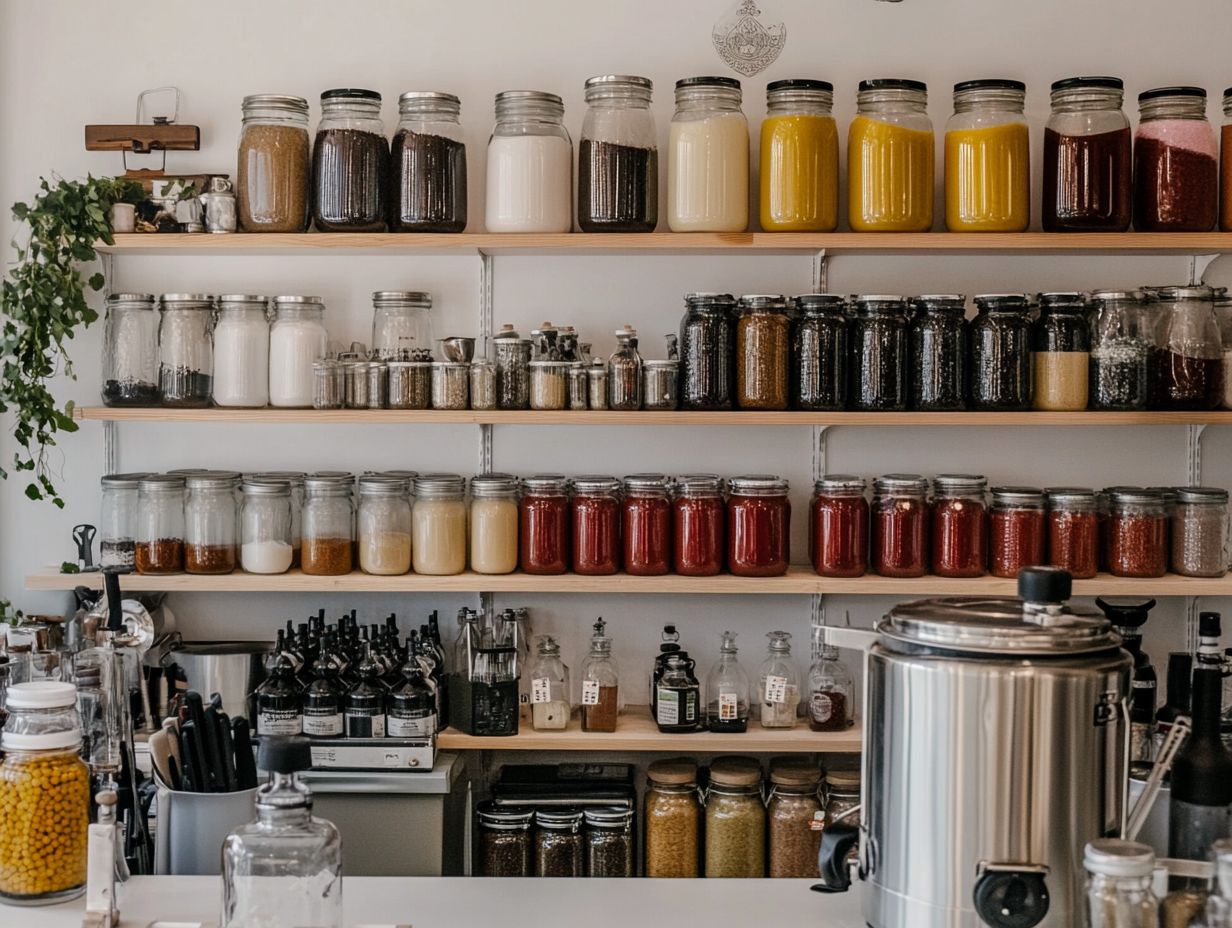
What are the best practices for storing canning equipment?
Clean and dry all canning equipment before storing it. To maintain quality, it’s crucial to store canned goods effectively in a cool and dry place, and organize equipment to prevent damage and ensure easy access.
How should I clean my canning jars and equipment before storing it?
Wash canning equipment with hot, soapy water and then dry it completely before storing. This helps prevent bacteria and mold growth.
Is it necessary to store canning equipment in a specific temperature?
Ideally, store canning equipment in a cool and dry place. Additionally, it’s important to learn how to properly store canned foods and avoid high humidity areas to prevent rust and deterioration.
What types of canning equipment should be stored separately?
Store sharp equipment or those with multiple parts, like jar lifters and can openers, separately to prevent damage to other items and ensure easy access.
Should I label jars and my stored canning equipment?
Labeling canning equipment is helpful, especially with a large collection. This makes it easier to find specific items and keep track of what you have.
How often should I inspect my stored canning equipment?
Don t wait! Inspect your stored canning equipment at least once a year. Check for signs of damage, rust, or wear, and replace any equipment that is no longer safe to use.

